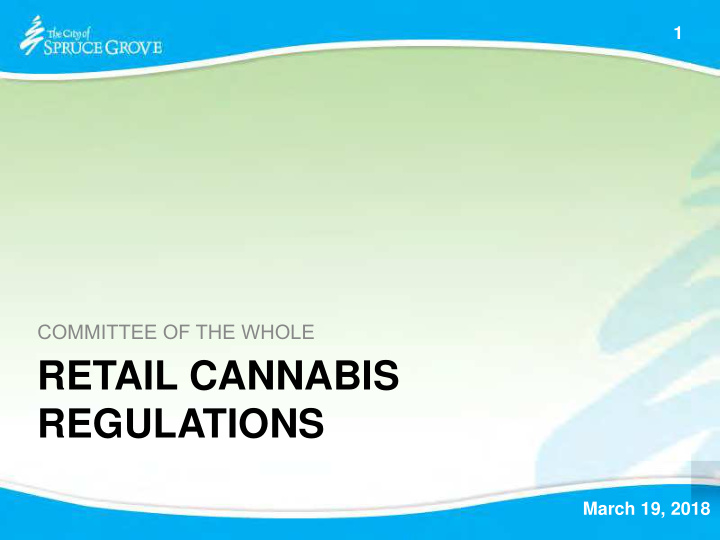



1 COMMITTEE OF THE WHOLE RETAIL CANNABIS REGULATIONS March 19, 2018
2 Legislative History • Bill C-45, the Cannabis Act, was passed in the House of Commons in November 2017 – Senate has agreed to third reading by June 8. – Can come into force between 8 weeks and 12 months from date of royal assent; TBD by Governor in Council. – Legislation gives authority to each province to determine the legislative framework, resulting in different regulations and approaches to retail cannabis across the country. • Bill 26, An Act to Control and Regulate Cannabis, was approved by the Alberta Legislature in December 2017. • Implementing regulations were released mid-February 2018.
3 Alberta’s Approach to Retail Cannabis • Storefront retail is privatized • Minimum 100 m separation from school sites and provincial health facilities • Retail cannabis must be a standalone business • Hours same as liquor stores • Extensive licensing requirements
4 Municipal Authority • No ‘opt out’ provision • Determine appropriate land use districts • Determine ‘sensitive uses’ in the community and adopt regulatory setbacks • Establish minimum separation distances between cannabis retail sales locations • Establish hours of operation • Define cannabis retail and other associated uses • Control variance powers of DOs and SDAB for above regulations
5 What are we trying to achieve? • Balance economic opportunity with public safety • Keep cannabis away from children • Minimize public nuisance and resource drain • Minimize land use impacts on other businesses
6 Land Use Bylaw or Business Licence Bylaw • Municipalities can choose how to regulate cannabis retail sales • Most municipalities in the region are opting to regulate primarily through LUB • City of SG is best set up for LUB regulation
7 Cannabis vs Alcohol Regulations • Cannabis sales are regulated differently than alcohol – AGLC setbacks for cannabis but not alcohol – Consuming cannabis can occur in more public places than alcohol, including parking lots, walkways, etc., associated with a development – Best practices where cannabis is already legal separate cannabis uses from sensitive uses and at greater distances
8 What are Sensitive Uses? • Uses that may be affected by another, or uses that may cause impacts when grouped together. • Provincial regulations: school sites and provincial health facilities (100 m) • Each municipality will determine what uses they want to be separated. – Common: daycares, parks, public facilities – Less common: religious facilities, arcades – Edmonton proposes setbacks to liquor stores; Calgary proposes setbacks to pawn shops, liquor stores, payday loans
9 Regulatory Considerations • Setbacks from sensitive uses are reciprocal • Land use districts that we choose for allowing cannabis retail need to: – Be safely accessible – Have appropriate facilities (parking, walkways, etc.) – Minimize impact on other sensitive uses
10 Proposed Land Use Districts • Proposing Vehicle Commercial and City Centre Districts only – Easily accessible by transit, bicycle, walking – Complementary uses – Appropriate parking availability • Vehicle Commercial private parking lots • City Centre on-street availability – Building code occupancy types that are easier to convert without major investment
11 Mapping of Sensitive Uses • Maps were prepared to help Council understand spatial distribution of sensitive uses • Understanding of provincial regulations are still evolving, so some maps may change slightly
12
13
14
15
16 Comparison of Setback Criteria Separation distance regulation Spruce Grove Edmonton Calgary U.S. Best (proposed) (proposed) (proposed) Practice 500 m 200 m 300 m 304 m Between cannabis retail uses 300 m 200 m 150 m 304 m Distance to schools 300 m 200 m n/a 304 m Distance to public library 100 m 100 m 100 m N/A Distance to Provincial health care facilities 100 m 200 m 10 m 304 m Distance to child care facilities 200 m 100 m n/a 304 m Distance to public parks 300 m 100 m n/a 304 m Distance to public recreation facilities n/a 100 m n/a 304 m Distance to liquor stores
17 Draft Recommendation
18 Separation Distances • Controls the cumulative impacts of several stores located in close proximity • Minimizes issues with public perception of areas with high concentration of certain uses – Investment potential – Property values • Allows the City to understand the impacts
19 Understanding Linear Commercial
20 Separation Distances • Staff recommendations on separation distance are dependent upon other setbacks from sensitive uses. • With only AGLC setbacks: – 200 m = up to 18 stores in C1 & C2 – 300 m = up to 12 stores in C1 & C2 – 500 m = up to 6 in C1 & C2
21 Variances • Variances or not? Administration is recommending key separation distances be included in use definition – No variances allowed by staff or SDAB – Allows a period of consistency in applying Council’s requirements – Gives clear understanding to Administration and reduces staff time in early years of adoption. – Could be reviewed and changed later by Council.
22 Application Intake • Proposed regulations will impact development permit intake process • Depending on restrictions, may need to have a lottery system for processing or other published date for acceptance of permits. • Further information will follow as part of the bylaw process.
23 Timelines • Develop bylaw: March to April • 1 st Reading: April 23 (target) • Public Hearing: May 14 th • 2 nd Reading: May 14 th
Recommend
More recommend